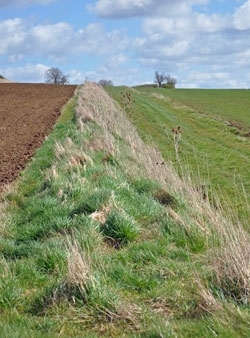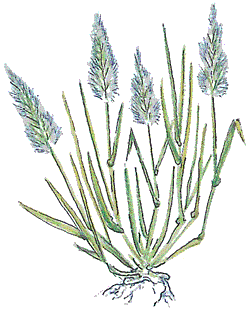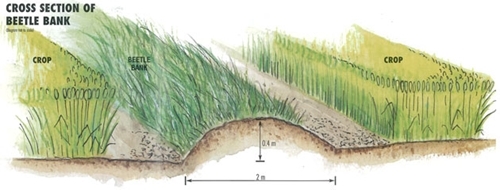 Given the right conditions, predatory insects and spiders can overwinter in field boundaries and in spring move into the crop, reducing pest numbers significantly. By providing places for them to spend the winter you can encourage winter boundary densities of more than 1,000 per square metre.
Given the right conditions, predatory insects and spiders can overwinter in field boundaries and in spring move into the crop, reducing pest numbers significantly. By providing places for them to spend the winter you can encourage winter boundary densities of more than 1,000 per square metre.
We now have fewer hedgerows than in the past, and less of the dense grass cover provided at their base by species such as Cock's-foot, Timothy and Red Fescue which can shelter and support beneficial insects and spiders. Modern field boundaries are often poor quality and do not create the ideal habitats for such insects to overwinter. There can also be problems with very large fields because it can take the predators several weeks to reach the centre of larger fields, as many of them cannot fly.
A simple way to encourage these predatory insects and spiders without interfering with your farm management is to create mid-field refuges, like hedge banks but without the woody shrubs, where predators can overwinter and from where they can spread across the crop in spring. The banks are easy to establish and are positioned so that normal cultivation can continue. The numbers of insects and spiders which inhabit such ridges can be even higher than in traditional/existing field boundaries.
During normal autumn cultivation create a ridge or earth bank approximately 0.4 metres high and 2 metres wide by careful two directional ploughing. The length of the ridge will depend on the size of the field but allow a working gap of one sprayer width at each end, so that you can continue to work the field as a single unit.
 Your ridges should be hand-sown with a mixture of perennial grasses containing tussock and mat-forming species such as Cock's-foot, Timothy and Red Fescue sown at 3g/m2. Tall growing wild flowers can be added to encourage other predatory groups such as hoverflies and parasitic wasps if desired (although this is more costly). Sow either when the ridges are formed (although a harsh winter may affect grass establishment) or in the following spring. You may need to first apply a broad spectrum, non-residual herbicide to remove any opportunist weeds which have appeared. Details of our recommendations for a grass mixture (species mix, and their proportions) can be obtained from our advisory department.
Your ridges should be hand-sown with a mixture of perennial grasses containing tussock and mat-forming species such as Cock's-foot, Timothy and Red Fescue sown at 3g/m2. Tall growing wild flowers can be added to encourage other predatory groups such as hoverflies and parasitic wasps if desired (although this is more costly). Sow either when the ridges are formed (although a harsh winter may affect grass establishment) or in the following spring. You may need to first apply a broad spectrum, non-residual herbicide to remove any opportunist weeds which have appeared. Details of our recommendations for a grass mixture (species mix, and their proportions) can be obtained from our advisory department.
The number of ridges you need in a field will depend on its size and on the quantity of its existing boundaries. As a rough guide, a square 16 hectare (40 acres) field will not need a beetle bank because insects will be across the whole field in reasonable numbers. However, a 20 hectare field (50 acres), which has established boundaries with raised underbanks and an abundance of tussocky grasses will need one ridge in its centre to achieve uniform cover in the early spring when the predators move into the crop. Fields of 30 to 50 hectares would ideally need three or four ridges, but even a single beetle bank would be helpful.

Once the ridges are established the grasses sown should exclude most weeds. A sterile strip between the ridge and the crop about 1m wide, rotovated or treated with a residual herbicide can minimise the risk of a grass weed herbicide applied to the crop damaging the grasses on the ridge. After the first year the ridges are best left uncut to allow tussocks to form. Thistles and docks may become established in the bank. These are best treated with a knapsack sprayer containing a suitable selective herbicide before they become abundant. Little other management of the ridges will be needed.
Two or three years after you have created them, your ridges will have developed into suitable habitats for overwintering insects and spiders, and your crops will have begun to benefit from their action on crop pests. If farming practices change, the ridges are easy to remove and re-create or create elsewhere.
FURTHER READING: Beetle banks – why and how to build them for farmland wildlife >
WATCH: How to establish the perfect beetle bank:
Get the Latest News & Advice
Join over 100,000 subscribers and stay updated on our latest advice, research, news and offers.
*You may change your mind any time. For more information, see our Privacy Policy.